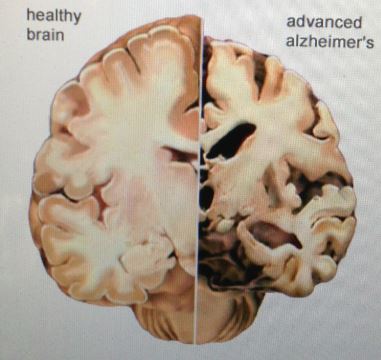What Effect Does Good Fats and Bad Fats Have on Alzheimer's
Omega 3 oils found to be beneficial...
In last month's issue of MicroBytes, we reported on newer research that discovered fungal elements in the brains of Alzheimer patients. Today we will look at the dietary connection.
Alzheimer’s Disease (AD) is a degenerative neurological disease that usually begins long before any noticeable symptoms occur. Alzheimer’s causes afflicted individuals to have decreased cognitive and memory function. This eventually leads to symptoms so severe that they interfere with the individual’s ability to perform everyday activities. (1) Alzheimer’s disease eventually leads to death.
The mechanism that causes Alzheimer’s disease is believed to be build-ups, or plaques, of proteins such as amyloid-β and tau in and around neurons and synapses between neurons. These plaques disrupt normal neuron communication. (2) The tau protein normally regulates the assembly and maintenance of microtubule structure in the neuron. In a diseased brain, tau protein disassemble causing free tau proteins to aggregate in neurofibrillary tangles (NFTs). This causes changes in both the histology of the brain and its behavior. (2)
Alzheimer’s disease and other related types of dementia effect an estimated 5.8 million people in the U.S. alone. Approximately 96% of these cases are in individuals who are aged 65 and older, though early on-set Alzheimer’s is possible. (3) Minority populations are disproportionately affected by Alzheimer’s disease and dementia related diseases. The increased risk of diabetes and heart disease in these populations is thought to be a factor for this relation as well. (3) Women are also twice as likely to develop Alzheimer’s disease in their lifetime. This is primarily because women live longer, as age is a major factor in the manifestation of Alzheimer’s symptoms. (3)
The mechanism for what causes the symptoms of Alzheimer’s is known but the root cause cannot always be pinpointed. Most cases are thought to be caused by a combination of genetic, environmental and lifestyle influenced factors. Diet is thought to be a substantial contributing factor over the course of an individual’s life.
Since the brain is made up of 60% fat, 25% of which is the omega 3 oil, DHA, it is important that we feed it healthy fats.(10) Certain types of foods, specifically saturated fats and trans fats have been found to be risk factors for the development of Alzheimer’s related cognitive impairments. (4, 5) Dose-response analysis indicated a 4 g/day increment of saturated fat intake was related to a 15% higher risk of Alzheimer’s disease. (5) Alternatively, there was not a significant association found between Alzheimer’s or dementia risk and dietary intake of monounsaturated and polyunsaturated fats. (5)
Artificial trans fats have already been banned in the U.S. due to their association with cardiovascular related diseases which are risk factors in development of Alzheimer’s. There is significant evidence of positive association between higher saturated fat intake and AD and dementia risk. However, there was no significant association found between dietary intake of total, monounsaturated, polyunsaturated fat and AD or dementia risk. (4)
There have been epidemiological studies that state reduced levels or dietary intake of ‘good’ fats like Omega-3 were also associated with increased risk of development of Alzheimer’s disease and cognitive decline. (5) In a population based study in New Zealand involving 2416 adolescents, there was a positive association of higher serum omega-3 concentration and physical and mental well-being. Higher omega-3 intake is associated with healthy metabolism, improved memory function, and improved attention and focus. (6) However, not all un-saturated fats are good in large amounts for physical and cognitive wellness. A healthy balance of omega-6 and omega-3 fatty acids has also been found to be a factor. The primary source of pro-inflammatory omega-6 fatty acids in the human diet is linoleic acid (LA) from the oils of seeds and grains. Sunflower, safflower, soy, and corn oils are particularly rich in linoleic acid. The primary dietary source of omega-3 fatty acids is alpha-linolenic acid (ALA) from seeds and seed oils that are derived from plants such as flax, walnuts, and canola. Fish and fish oils are the richest source of preformed long chain omega-3 fatty acids, Eicosapentaenoic Acid (EPA) and Docosahexaenoic Acid (DHA).(6)
Prior to the industrial revolution humans consumed a diet that was around a 1:1 ratio of omega 3 and omega 6 fatty acids. Due to advances in technology allowing for easy refining of vegetable and seed oils as well as having livestock (including fish) with diets high in omega-6 containing grains, this ratio is more like 20:1 today. There is ample evidence suggesting diets that contain a high-intake in omega-6 fatty acids promote inflammation and thrombosis which can lead to further cardiac and neurological issues downstream. (6)
There have also been studies that indicated that a lower ratio of omega 6 to omega 3 intake strongly predicts more accurate hippocampus-related spatial memory and cognitive function. A lower omega 6 to omega 3 ratio resulted in faster learning and navigational skills among test subjects as well as higher overall cognitive status. (7, 8) Another study found that ingestion of omega-3 fatty acid supplements increases learning, memory, cognitive well-being, and blood flow in the brain.(9)
There is a consensus that consuming a well-balanced heart healthy diet high in mono-unsaturated (omega 9) and omega 3 fats from fish, nuts, olive oil, avocado oil, etc. in place of saturated and poly-unsaturated fats (omega 6) is essential in not only cardiovascular health but also neurological health. Maintaining a lower omega-3 and omega-6 fatty acid ratio, limiting refined sugars, saturated fats and red meats in your diet can lead to a longer lifespan as well as an added benefit of a much higher quality of life.
Meet the author

TECHNICAL SUPPORT SPECIALIST I at HARDY DIAGNOSTICS
Joe Tripp
Joe has been a Technical Support Representative at Hardy Diagnostics since 2022. Upon graduating from Northewest Missouri State University, Joe began his career working in the quality control laboratory of a medical test and media manufacturing facility. In this position he gained experience with a wide variety of testing for different media types, as well as expereince with automated AST and blood culture systems. Joe enjoys playing golf as much as possible and getting out to Colorado at least twice a year to snowboard.









